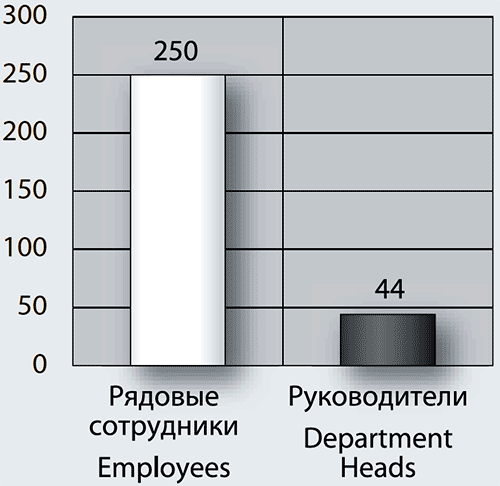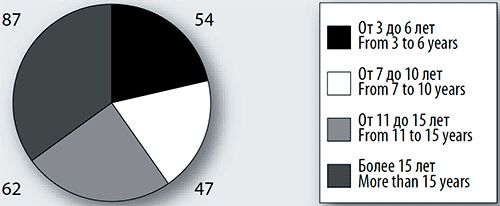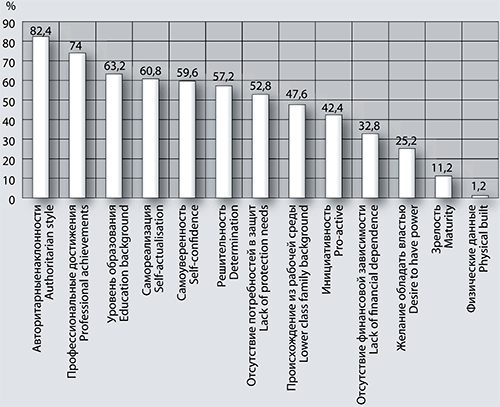Personality traits of department heads in the internal affairs bodies
Recieved: 06/02/2019
Accepted: 02/16/2020
Published: 03/31/2020
Pages: 107-114
DOI: 10.11621/npj.2020.0110
Keywords: legal psychology; internal affairs bodies; personality traits; transformation processes; professional activity; leader
Available online: 31.03.2020
Porshukov Andrey S. (2020). Personality traits of department heads in the internal affairs bodies. National Psychological Journal, (1) , 107-114. https://doi.org/10.11621/npj.2020.0110
Copied to Clipboard
CopyAbstract
Background. In today’s science, the issue of changes in the internal affairs bodies management is one of the most crucial ones. In carrying out their duties the department heads must protect the rights and legitimate interests of citizens in accordance with the law. They are allowed to restrict the rights of citizens if it is required by their professional duties. That is why further development of a scientifically based approach to high department heads in the internal affairs bodies as a trigger for transformation processes should be recognized as absolutely relevant.
Objective. Identifying major personality traits required for high executive posts in the internal affairs body; identifying the most significant personality traits and management style of the department heads in the territorial internal affairs bodies; studying individual psychological determinants of career adaptability of internal affairs bodies department heads.
Design. The empirical research was carried out in the internal affairs agencies of the Krasnoyarsk Krai territorial unit and included three stages: 1. Conducting a survey among employees to identify the most significant personality traits required for high executive posts in the internal affairs body. The sample included 250 respondents with work experience from 3 to 25 years. 2. Conducting a survey aimed at determining the management style. The sample included 44 respondents. 3. Studying individual career adaptability of internal affairs bodies department heads. The following methods were used: “Adaptivity” (multi-factor personality test) method by A.G. Maklakov and S.V. Chermyanin was used to diagnose social adaptation; R. Cattel’s polyfactorial personal questionnaire; G. Eysenck Personality Inventory (EPI) questionnaire; A.Kokoshkarova Questionnaire for neuroticism and tendentious personal deviations (QNTPD); Bass-Darki aggression methods. To determine neuropsychic stability, the “Prognosis” method was used. The sample included 44 respondents.
Results. The level of career adaptability in department heads of the territorial internal affairs agencies of the Krasnoyarsk Krai Territory is directly related to neuropsychic stability, which is due to the presence of significant correlations with the “Prognosis” method (0.8267). There are significant correlations of career adaptability with indicators of neurasthenia (0.4398) and vegetative disorders (0.4121) according to Kokoshkarova method. According to the results of the mathematical-statistical analysis of the relationships of career adaptability with the Cattell method, significant correlations were identified: C (-0.3659) – increase in emotional stability with the development of career adaptability; L (0.2758) – confidence; H (-0,2617) – leader’s courage and psychological readiness for justified risk; M (0,1922) – adaptability to everyday service and practical views protects the manager from losing touch with reality; N (0.1198) – career adaptability develops, straightforward behavior substitutes avoiding excessive scheming or inappropriate flexibility.
Conclusion. The results can be used by practical psychologists when working with department heads of the territorial internal affairs agencies located in the republics of Hakassia, Tyva, Altay, Krasnoyarsk Krai, in the regions of Irkutsk, Kemerov, Tomsk. Further research to determine the impact of management conditions on transformations in the department heads ‘s personality is to be conducted.

Fig. 1. Respondents distribution

Fig. 2. Employees by work experience distribution

Fig. 3. Personality traits of the department heads in territorial police departments, Krasnoyarsk Krai Territory (Giselli,%)
Table 1. Management style of department heads
|
Management style |
Description |
N Respondents |
|
Determination |
The moral quality of the leader expressed in the consistent observance and upholding of certain principles, beliefs |
37 |
|
Competence, search for novelty |
Integral characteristics that reflect the level and nature of competence and how the person performs their activities at high level. It provides for the employee to ensure high work productivity, the effective implementation of professional activities in collaboration with other people, the presence of career-oriented qualities of the employee’s personality |
44 |
|
Career efficiency |
High ideology and consciousness, perseverance and strict discipline in work |
32 |
|
Organizational skills |
Are expressed in ordering, organization, achieving unity of work. The leaders do not only organize the activities of their subordinates, but also give them a certain focus, know how to justify the goal creating the right value orientation |
41 |
|
Critical thinking and critical assessment |
Determines the level of the leader’s self-esteem |
39 |
|
Being demanding and taking care of others |
Demanding for people, i.e. a high level of requirements for how subordinates behave and show themselves, to the quality of their behaviour. The demanding leaders expect themselves and the subordinates to be pro-active, responsible, cultured. |
35 |
|
Personal responsibility |
“I can” and “I must” fulfill my obligations, together with my internal duty to answer for the consequences of my actions |
32 |
|
Unity of word and deed |
High responsibility, discipline and culture |
37 |
|
Intolerance to bureaucracy, formalism, self-satisfaction |
Carrying out coercion, control and threats of punishment |
31 |
Table 2. Career adaptability correlated with personality traits of department heads (“Adaptivity” multi-factor personality test).
|
Personality Traits |
Career Adaptability |
|
Prognosis Test Results |
0.8267** |
|
Eysenck EPI Neurotism Scale |
0.4084** |
|
Kokoshkarova Neurasthenia Test |
0.4398** |
|
Kokoshkarova Autonomic DisturbancesTest |
0.4121** |
|
Cattel Factor С |
-0.3659* |
|
Bass-Darki Suspicion Test |
0.3097* |
** – statistic verification (р≤0,01)
* – statistic verification (р≤0,05)
References
References:
Alderson W. (1995). Value of the Person: Theory R Concept, Pittsburgh: Value of the Person, 192–210.
Anderson T. D. (2000). Every officer is a leader. New York: St. Lucie Press, 408.
Andreeva I.A. & Korchmaryuk V.A. (2008). Methods of organizing socio-psychological research in the internal affairs bodies: manual. Moscow, TSOKR MVD Rossii.
Bakumenko V.D. (2007). Trends and factors of influence of public administration transformations on the adoption of public management decisions. [Gosudarstvennoe upravlenie. Elektronnyy vestnik], 11,1–8.
Blanchard K.H. (1997). Mission possible: Becoming a world-class organization. New York: McGrow-Hill, 366.
Buss D., & Cantor N. (Eds). (1989). Personality psychology. Recent trends and emerging directions. N.-Y., ets.: Springer-Verlag. doi: 10.1007/978-1-4684- 0634-4
Cattell R. (1965). The Scientific Analysis of Personality. London: Penguin Books, Limited, 225.
(1995). Eysenck Personality Inventory (EPI) questionnaire. [Almanakh psikhologicheskikh testov], Moscow, 217–224.
Fiedler F.E. (1992). How do you make leaders more effective: new answers to an old puzzle. Organizational Dynamics, Autumn, 3–18. doi: 10.1016/0090-2616(72)90008-3
Greene J. (1998). Evaluating Planned Change Strategies in Modern Law Enforcement: Implementing Community-Based Policing. Brodeur J.P, 146.
Ivkovic S.K. (2008). The Contours of Police Integrity across Eastern Europe. International Criminal Justice Review, 18(1), 59–82. doi: 10.1177/1057567708315621
Kazak T.V. (2015). Professional self-actualization and psychosocial adaptation of employees of internal affairs bodies: monograph. Minsk, RIVSH, 360.
Kelsen H. (1961). General Theory of Low and State. New–York: Russell and Russell, 230–231.
Korenev A.P. (2002). Fundamentals of management in the internal affairs bodies: Textbook for universities. Moscow, Moskovskiy universitet MVD Rossii.
Kubyshko V.L. (2017). Improving the psychological work in the system of moral and psychological support for the operational and official activities of the personnel of the internal affairs bodies. National Psychological Journal, 4(28), 95–103. doi: 10.11621/npj.2017.0409
Nickerson R.S., Perkins D.N. & Smith E.E. (1985). The teaching of thinking. Hillsdale, NJ: Erlbaum.
Petrov V.E., & Maltseva T.V. (2013). Psychological consultation of employees of internal affairs bodies. [Vserossiyskiy institut povysheniya kvalifikatsii sotrudnikov MVD Rossii]. Domodedovo.
Pryakhina M.V. (2009). The organization of the psychological service in the internal affairs bodies: Textbook. St. Petersburg, Izdatel’stvo SPb universiteta MVD Rossii, 314.
Pugacheva E.V. (2011). Development of managerial competence in the department heads of internal affairs bodies: Monograph. Moscow, Ministerstvovo vnutrennikh del Rossiyskoy Federatsii, Akademiya Ekonomicheskoy bezopasnosti.
Raygorodsky D.Ya. (Ed.) (2001). Multilevel personality questionnaire “Adaptability” (MLO-AM) by A.G. Maklakova and S.V. Chermyanina. [Prakticheskaya psikhodiagnostika. Metodiki i testy. Uchebnoe posobie]. Samara, 549-558.
Rean A.A. (2006). Psychology of personality adaptation. Analysis. Theory. Practice. SPb, Prime-EUROSNAK, 479.
Roe A. (1956). The Psychology of occupations. N.Y.: Willey, 348. doi: 10.1037/13192-000
Somov A.V., & Maltseva T.V. (2012). Personal qualities and their importance in managerial activities of the head of internal affairs bodies. [Prikladnaya yuridicheskaya psikhologiya], 4, 105–109.
Stevens D.J. (2001). Community policing and managerial techniques: total quality-management techniques. The Police Journal, 74, 26–41. doi: 10.1177/0032258X0107400104
Stolyarenko A.M. (Ed.) (2001). Applied legal psychology: Textbook. The allowance for universities. Moscow, UNITY-DANA, 34.
Super D.E., & Bahn M.J. (1971). Occupational psychology. London, Tavistock.
Thibault E. A., Lynch L. M., & McBride R. B. (2001). Proactive Police Management. New York: Prentice Hall, 340.
The Police Community of the Americas (Ameripol). Retrieved from: https://en.wikipedia.org/wiki/Ameripol (accessed: 25.09.2019).
Vakhnina V.V. (2000). Psychological features of motivation of the heads of the police department: Ph.D. in Psychology, Thesis. Moscow.
Vakhnina V.V., & Trubochkin V.P. (2005). Diagnosis and motivational of employees for service in law enforcement bodies: manual. Moscow.
Porshukov Andrey S.. Personality traits of department heads in the internal affairs bodies. // National Psychological Journal 2020. 1. Pages107-114. doi: 10.11621/npj.2020.0110
Copied to Clipboard
Copy

